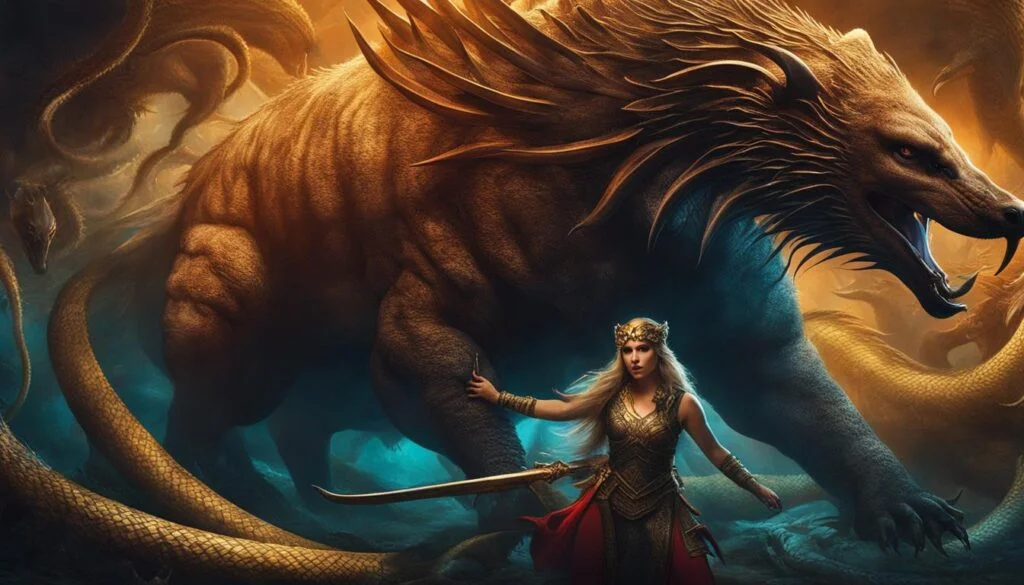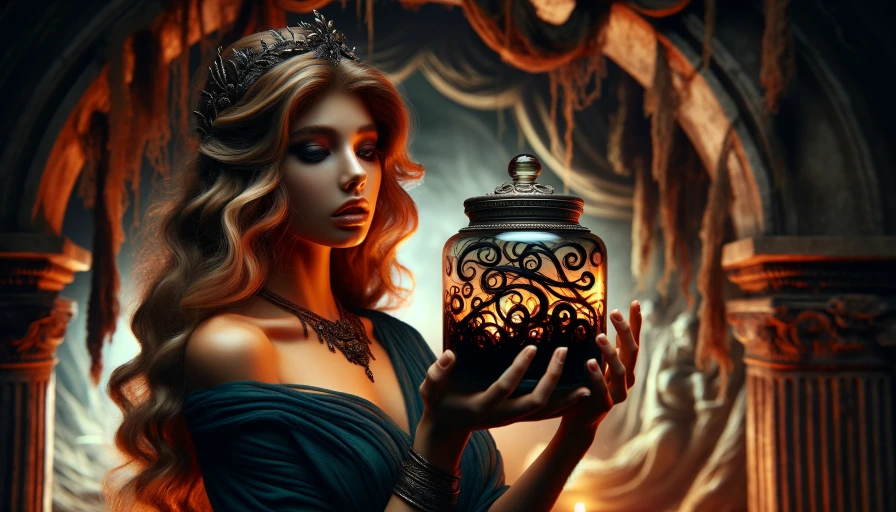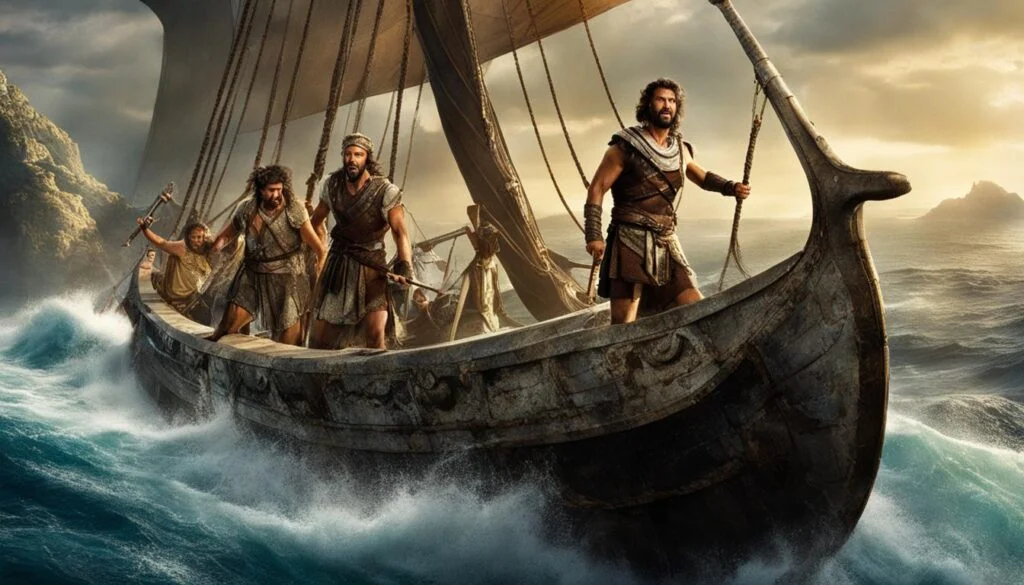Welcome to our exploration of Greek mythology, where we delve into the intriguing world of ancient creatures and legends. Today, we shine a spotlight on Echidna, a mythical being with a fascinating role in Greek mythology. Known as the “Mother of All Monsters,” Echidna’s story is intertwined with the creation of terrifying creatures that continue to captivate our imaginations.
Key Takeaways:
- Echidna, a hybrid creature, is described as a half-woman, half-snake being in Greek mythology.
- She is known as the “Mother of All Monsters” and was the offspring of the primal gods Gaia and Tartarus.
- Echidna’s terrifying children include Hydra, Cerberus, the Nemean Lion, and the Chimera.
- She played a significant role in the creation of dark forces that endangered humans.
- Echidna’s story is often overshadowed by her famous monstrous offspring.
Echidna’s Terrifying Offspring
When it comes to terrifying creatures in Greek mythology, Echidna’s offspring take center stage. Her children are the stuff of nightmares, known for their monstrous forms and deadly abilities. Let’s explore some of her most famous and feared progeny:
1. Hydra
The Hydra is a multi-headed water serpent that strikes fear into the hearts of mortals. Each time one of its heads is cut off, two more grow in its place, making it nearly impossible to defeat. This formidable creature is often depicted as a symbol of chaos and destruction.
2. Cerberus
Cerberus, the three-headed hound, stands guard at the gates of the Underworld. Its mission is to keep the souls of the deceased from escaping. With its venomous breath and fearsome appearance, Cerberus serves as a formidable obstacle for anyone attempting to enter or exit the realm of the dead.
3. Nemean Lion
The Nemean Lion is a monstrous beast with impenetrable golden fur. Its incredible strength and invulnerability make it a deadly opponent for any hero. It is often associated with the labors of Heracles, who was tasked with slaying the lion as one of his twelve legendary feats.
4. Chimera
The Chimera is a fearsome creature with the body of a lion, the head of a goat, and a serpent’s tail. It possesses the ability to breathe fire, making it an incredibly dangerous adversary. The Chimera is often portrayed as a symbol of destruction and chaos, representing the inherent dangers of the natural world.
These monstrous offspring of Echidna played significant roles in various Greek myths and were formidable challenges for heroes like Heracles. Their terrifying abilities and unique forms continue to captivate audiences and showcase the dark side of Greek mythology.
Echidna’s Encounter with Heracles
One of the notable encounters in Greek mythology involving Echidna is her interaction with the legendary hero Heracles. According to the accounts of the Greek historian Herodotus, Heracles crossed paths with Echidna while on a quest to find his stolen horses. Echidna made him a proposition: she would return his horses if Heracles agreed to have a sexual encounter with her. Heracles agreed, and from this union, three sons were born.
Aside from her association with Heracles, Echidna also has ties to the monstrous Typhon. Typhon, a creature of immense power and fury, was sealed beneath Mount Etna by the god Zeus. Echidna and Typhon’s connection is not fully explored in the myths, but the mere mention of their association adds to the intrigue surrounding Echidna’s character.
While Echidna’s role in these encounters is significant, she often takes a backseat to her more famous and terrifying offspring. The focus of Greek mythology tends to shift towards the exploits and challenges faced by heroes like Heracles in dealing with Echidna’s monstrous children.
Echidna’s Immortality and Challenges to Heroes
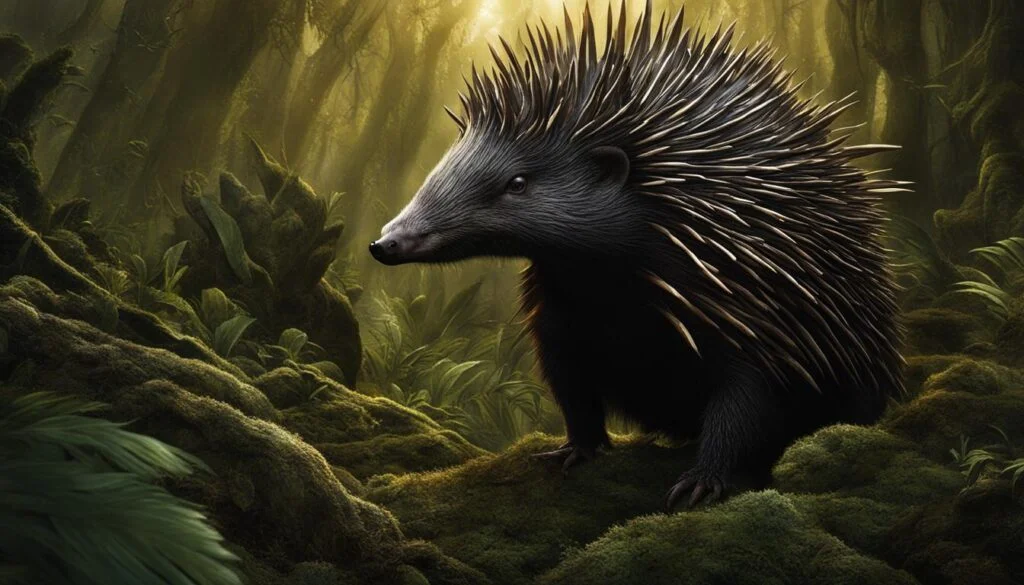
In Greek mythology, Echidna is a captivating character known as the “Mother of All Monsters.” While her terrifying offspring often steal the spotlight, Echidna herself possesses a unique characteristic that sets her apart – immortality. According to some accounts, Zeus left Echidna on Earth after the victory over the Titans, ensuring that she and her descendants would continue to challenge future heroes.
Echidna’s immortality adds an intriguing layer to her role in Greek mythology. While she is often associated with her monstrous children, her immortal status suggests a more significant role in the grand scheme of ancient Greek stories. As an immortal figure, Echidna has the power to shape the destiny of heroes, pitting them against her fearsome descendants and testing their strength and courage.
The Titans and Echidna’s Immortality
Echidna’s immortality is closely tied to the ancient Greek story of the Titans. After Zeus and the Olympian gods defeated the Titans in a great battle, Echidna was left on Earth as a constant reminder of the dark forces that threatened humanity. Her immortal presence serves as a reminder that the heroic age is never truly free from danger, with Echidna and her monstrous offspring always lurking in the shadows, ready to challenge and test mortal heroes.
Echidna’s Role in Challenging Heroes
As the “Mother of All Monsters,” Echidna’s primary role is to challenge and obstruct heroes in their quests. Her offspring, such as Hydra, Cerberus, the Nemean Lion, and the Chimera, pose formidable threats that test the limits of mortal strength and ingenuity. Echidna’s immortality allows her to continue spawning these monstrous creatures, ensuring that heroes will constantly face new and dangerous obstacles in their heroic journeys.
While Echidna herself may not appear directly in many myths, her immortal presence serves as a catalyst for the creation of these monstrous challenges that heroes must face. It is through her role as a mother that Echidna’s true power and influence are revealed, cementing her status as a formidable figure in Greek mythology.
Echidna’s Descriptions in Greek Mythology
In Greek mythology, Echidna is often described as a fearsome and monstrous creature. She is depicted as a nymph with glancing eyes and fair cheeks, combined with the body of a huge, awful serpent. Echidna dwells in a cave deep under a hollow rock, representing her connection with the earth and chthonic forces. Her half-woman, half-serpent form is sometimes depicted with wings, further emphasizing her terrifying nature.
As the “Mother of All Monsters,” Echidna is renowned for her role in mothering many terrifying creatures. Her monstrous offspring include Hydra, a multi-headed water serpent; Cerberus, the three-headed hound that guarded the entrance to the Underworld; the Nemean Lion, a monstrous lion with impenetrable skin; and the Chimera, a creature with the body of a lion, the head of a goat, and a serpent’s tail. These creatures played significant roles in various Greek myths, posing challenges for heroes like Heracles.
The descriptions of Echidna in Greek mythology highlight her immense power, her association with decay and disease, and her role in creating dark forces that continued to haunt and endanger humans. Although overshadowed by her famous offspring, Echidna remains a captivating and essential figure in the pantheon of ancient Greek creatures.
The Name and Origin of Echidna
When it comes to the name “Echidna,” its origins can be traced back to the Greek word meaning “viper.” This name was given to the mythological creature because she was depicted as having the combined form of a woman and a serpent. Interestingly, this association with both womanhood and serpents is what inspired French naturalist Baron Georges Cuvier to name the unique animals found in Australia “echidna.” The parallel between these animals and the hybrid nature of the Greek mythical creature, Echidna, is striking.
To better understand the etymology of Echidna’s name, we must delve into the rich world of Greek mythology. Echidna is a captivating character associated with the creation of monstrous creatures and dark forces. As the “Mother of All Monsters,” she played a prominent role in Greek myths, although her focus often shifts to her terrifying offspring. Possessing a hybrid nature as a half-woman, half-serpent, Echidna embodies the duality of feminine grace and serpentine power.
The Influence of Echidna’s Name
- The Greek word “echidna” meaning “viper” reflects Echidna’s serpentine form and connections to the underworld.
- French naturalist Baron Georges Cuvier named the unique Australian animals “echidna” due to their resemblance to the woman/serpent nature of the Greek mythological creature.
Echidna’s name not only carries historical and mythological significance but also has a lasting impact on our understanding of hybrid creatures in both ancient and modern contexts. By exploring the etymology of her name, we gain further insights into the symbolic nature of Echidna and her enduring presence in Greek mythology.
Echidna’s Role as a Protector
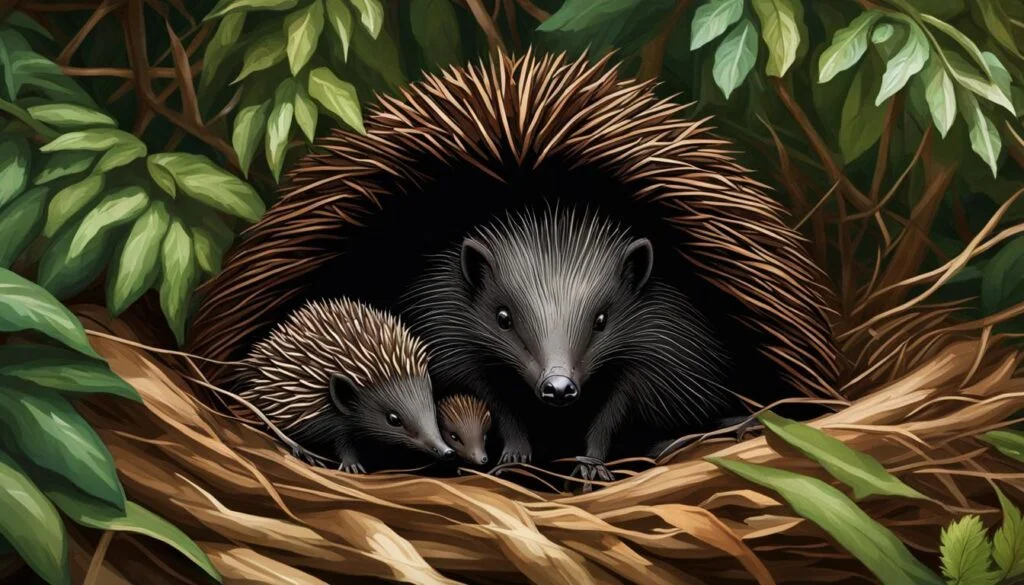
In addition to her terrifying reputation as the “Mother of All Monsters,” Echidna also had a lesser-known role as a protector in Greek mythology. Depicted in archaic vase-paintings, Echidna is shown performing sacred rites while echidnas attack the vines in vineyards. This portrayal highlights her connection to fertility and the earth, emphasizing her chthonic nature. As a symbol of protection, Echidna safeguards the vineyards, ensuring the growth and prosperity of the crops.
Echidna and the Vineyards
Echidna’s association with vineyards goes beyond her protective role. In ancient Greek culture, vineyards were of great importance as they produced wine, a divine drink associated with celebration and religious rituals. By safeguarding the vineyards, Echidna ensured the abundance of grapes and the production of high-quality wine, which played a vital role in Greek society. Her presence in these depictions emphasizes her significance in both agricultural and religious contexts.
Echidna’s Chthonic Nature
Echidna’s connection to vineyards further highlights her chthonic nature. Chthonic beings were associated with the underworld and the earth’s fertile, dark depths. As the “Mother of All Monsters,” Echidna embodied the corruptive forces in nature and represented the decay and disease that can emerge from the earth. By protecting the vineyards, Echidna asserted her authority over the chthonic forces, ensuring a harmonious balance between the fertile earth and the growth of crops.
Echidna’s Legacy as a Protector
While Echidna’s role as a protector may be overshadowed by her monstrous offspring, her depiction in ancient artwork and mythology demonstrates her multifaceted nature. From her terrifying reputation as the mother of legendary creatures to her role as a guardian of vineyards, Echidna’s legacy showcases the complex and diverse nature of Greek mythology. As we explore the depths of ancient Greek creatures, Echidna’s presence reminds us of the intricate and interconnected web of beings that defined this rich mythological tradition.
Conclusion
In Greek mythology, Echidna is an intriguing character that holds a significant place in the realm of ancient Greek creatures. As the “Mother of All Monsters,” she played a vital role in the creation of terrifying beings and dark forces. Despite her prominence, Echidna’s focus often shifts to her monstrous offspring, overshadowing her own unique hybrid nature.
Echidna’s depiction as a gigantic half-woman, half-snake highlights her association with both womanhood and serpents. This connection adds to her captivating allure in Greek mythology. Her role as the offspring of the primal gods Gaia and Tartarus further solidifies her status as a noteworthy figure in ancient Greek lore.
While Echidna’s mythical presence is intriguing, her direct involvement in Greek myths is relatively limited. Nevertheless, her influence is felt through the creation of fearsome creatures like Hydra, Cerberus, the Nemean Lion, and the Chimera. These monstrous offspring provided formidable challenges for renowned heroes such as Heracles.
In summary, Echidna’s hybrid nature, association with monstrous creatures, and her chthonic roots make her an essential part of the pantheon of ancient Greek creatures. Her immense contributions to Greek mythology continue to fascinate us as she represents the corruption of the earth and the enduring presence of dark forces.
FAQ
What is Echidna’s role in Greek mythology?
Echidna is known as the “Mother of All Monsters” and is associated with the creation of terrifying creatures and dark forces.
Who are Echidna’s most famous offspring?
Echidna’s terrifying offspring include Hydra, Cerberus, the Nemean Lion, and the Chimera, among others.
Did Echidna have an encounter with Heracles?
According to Greek historian Herodotus, Echidna had an encounter with Heracles, resulting in the birth of three sons.
Is Echidna immortal?
According to some accounts, Echidna is immortal, but she played a more indirect role in Greek mythology compared to her monstrous offspring.
How is Echidna described in Greek mythology?
Echidna is often described as a fearsome and monstrous creature, a nymph with glancing eyes and fair cheeks combined with the body of a huge, awful serpent.
What is the origin of Echidna’s name?
The name “Echidna” comes from the Greek word meaning “viper,” as her hybrid nature resembled that of a woman and serpent.
Was Echidna a protector?
Echidna is sometimes depicted as a protector, particularly in vineyards, symbolizing her connection to fertility and the earth.
What is the significance of Echidna in Greek mythology?
Echidna’s role in Greek mythology is as the “Mother of All Monsters,” representing the creation of dark forces and continuing to haunt and endanger humans.


